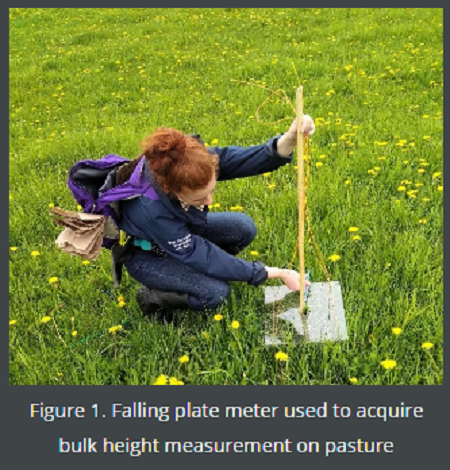What is a Falling Plate Meter?
A falling plate meter is a tool that can be used to estimate dry matter yield within grazing pastures (Rayburn and Lozier, 2003b). To do this, an acrylic plate is lowered against a metre stick in the center of the plate, onto the grass. At the point the plate is entirely held up by the grass, a bulk height measurement can be acquired on the metre stick (Figure 1). Generally, in pasture management, a pasture height measurement has been used as a dry matter estimation method. However, bulk height is a more accurate estimate of dry matter yield when compared to other nondestructive methods because a plate meter accounts for the density of the sward (Rayburn and Lozier, 2003a).

A falling plate meter can only be an effective tool in specific settings. This tool loses precision as grass matures, therefore, only grass in a vegetative state can be estimated accurately (Castle, 1977). Like the structure of mature grass, species with more stocky stems such as alfalfa cannot accurately be estimated (Griggs and Stringer, 1988). Measuring pasture post-grazing depends on the state of the grass. If trampled severely enough that swards are no longer upright, a falling plate meter is not of much use (Li et al., 1998). In the same sense, lodged grasses are also not able to be estimated accurately using this tool.
Current Research
Previous research surrounding falling plate meters focuses on geographical locations which primarily have one dominant grass species in pastures. Comparing this to Ontario pastures, there is a vast biodiversity of grass species. This makes it difficult to relate studies previously conducted in other locations to Ontario’s unique pastures. Therefore, a calibration of the falling plate meter must be completed specifically for pasture within Ontario.
Bulk height measurements were taken to form the calibration curve along with dry matter yield values of each sample. The dry matter yield was calculated using a tool called a quadrat which outlines the same area of grass the plate meter is being used on. In this case, the area of the quadrat is 0.092903 m2. This grass is then clipped at 5 cm, the minimum height at which ruminants should graze down to. The sample is weighed, dried and weighed again to determine the dry matter content. Yield is calculated and reported in kg/ha using the following equation: ((dry weight (g) x 0.001) x (10,000/quadrat size (cm2))).
Bulk height values on the x-axis are then graphed against yield on the y-axis to create a correlation between bulk height and dry matter yield.
After 12 weeks of sampling from May 14th, 2019 to August 7th, 2019, a preliminary calibration curve has been developed with a relatively high correlation. Over the next few years, the plan is to continue sampling to build a statistically robust calibration curve across many different weather patterns over differing seasons.
Research Implications
This type of inexpensive, easy to construct, pasture measurement tool would allow Ontario farmers the ability to take measurements of their own pastures with minimal training required. Gaining accurate dry matter estimations on pastures would better allow best management grazing pastures to be implemented.
Access to tools that promote good grazing management would help put a value on pastures within the grazing industry. In turn, pasture management will turn into pasture gains which proportionally affect livestock production and the ruminant industry as a whole.